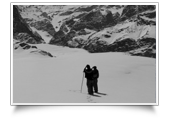|
Mountain Climbing
in Ladakh |
 |
| |
|
The Nun-Kun Massif in Himalayas |
 Nun-Kun Massif in the Great Himalayan Range is the area most frequented by foreign climbers. The easy connectivity to this place from the Kargil-Pudum road makes this the most attractive climbing destination in the Great Himalaya. It has six known peaks which are accessible from the Suru Valley. Of these Nun standing tall at a height of 7,135m and Kun measuring a close second at 7,077m are the highest summits. Climbing it needs advance booking years ahead.
Nun-Kun Massif in the Great Himalayan Range is the area most frequented by foreign climbers. The easy connectivity to this place from the Kargil-Pudum road makes this the most attractive climbing destination in the Great Himalaya. It has six known peaks which are accessible from the Suru Valley. Of these Nun standing tall at a height of 7,135m and Kun measuring a close second at 7,077m are the highest summits. Climbing it needs advance booking years ahead. |
|
| Stok-khangri Massif in Zanskar Range |
 Another popular area for climbing is Stok-khangri Massif in the Zanskar Mountains, south of Leh. The base camp for climbing the various peaks of this range is at a distance of about two days trek from the village of Stok. Stok-khangri with a height of 6,150m is the highest among its known peaks. Gulap Khangri (5,900 m), Matho West (5,950m) and Kantak (5,275 m) are the other peaks in this area. Another popular area for climbing is Stok-khangri Massif in the Zanskar Mountains, south of Leh. The base camp for climbing the various peaks of this range is at a distance of about two days trek from the village of Stok. Stok-khangri with a height of 6,150m is the highest among its known peaks. Gulap Khangri (5,900 m), Matho West (5,950m) and Kantak (5,275 m) are the other peaks in this area. |
|
|
Karakoram Range |
 Karokoram is a popular range which lies across the Ladakh and the Nubra Valley in North of Leh. Saser-I (7,415 m), Saser -II (7,513m) and Saser III (7,495 m) are the most prominent summits in this range which are accessible from various parts of the Nubra Valley. The other peaks lie within the restricted area and are not freely accessible to foreign climbers except with special permission from the Government of India.
Karokoram is a popular range which lies across the Ladakh and the Nubra Valley in North of Leh. Saser-I (7,415 m), Saser -II (7,513m) and Saser III (7,495 m) are the most prominent summits in this range which are accessible from various parts of the Nubra Valley. The other peaks lie within the restricted area and are not freely accessible to foreign climbers except with special permission from the Government of India. |
|
Permits required for climbing listed peaks:
Climbing expeditions are required to obtain permission from the Indian Mountaineering Foundation for climbing all listed peaks. A booking fee, based on the height and popularity of the allotted peak, is charged and a Liaison Officer is assigned to every climbing team. The minimum period required for processing applications is six months. Every authorized expedition is provided with adequate rescue coverage in the events of accidents and illness.
Best time to visit:
The climbing season in Ladakh extends from mid-May to mid-October, the ideal period being from June to September because it is during this time that Ladakh remains unaffected by the monsoon, which holds sway over most of the Himalayas. |
